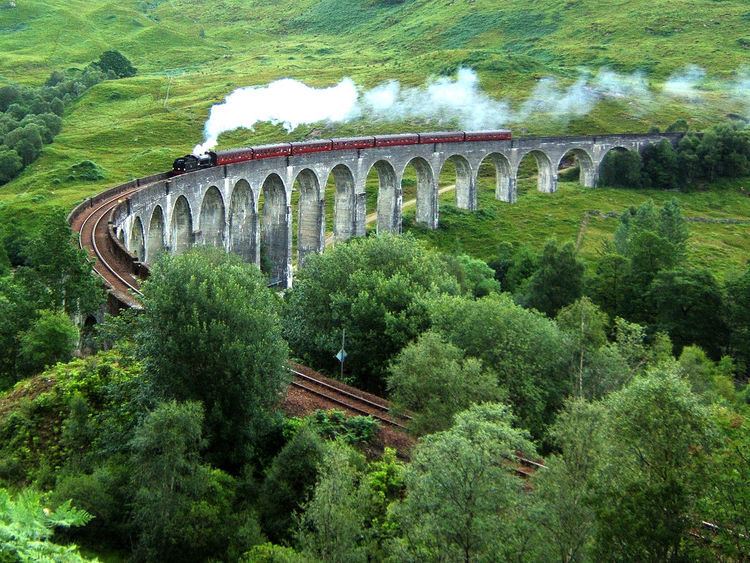Longest span 50 feet (15 m) Engineering design by Simpson & Wilson Construction started July 1897 Opened 1 April 1901 | Crosses River Finnan No. of spans 21 Height 30 m | |
 | ||
Hours Open today · Open 24 hoursTuesdayOpen 24 hoursWednesdayOpen 24 hoursThursdayOpen 24 hoursFridayOpen 24 hoursSaturdayOpen 24 hoursSundayOpen 24 hoursMondayOpen 24 hours Similar The Jacobite, Loch Shiel, Glenfinnan railway station, Ben Nevis, Eilean Donan Castle | ||
the midsummer west highlander on glenfinnan viaduct 09 06 12
The Glenfinnan Viaduct is a railway viaduct on the West Highland Line in Glenfinnan, Inverness-shire, Scotland. Located at the top of Loch Shiel in the West Highlands of Scotland, the viaduct overlooks the Glenfinnan Monument and the waters of Loch Shiel.
Contents
- the midsummer west highlander on glenfinnan viaduct 09 06 12
- Glenfinnan viaduct and steam train from the air by quadcopter
- Construction
- Design
- Railway services
- Depiction
- References
Glenfinnan viaduct and steam train from the air by quadcopter
Construction
The West Highland Railway was built to Fort William by Lucas and Aird, but there were delays with the West Highland Railway Mallaig Extension (Guarantee) bill for the Mallaig Extension Railway in the House of Commons as the Tory and Liberal parties fought over the issue of subsidies for public transport. This Act did pass in 1896, by which time Lucas & Aird (and their workers) had moved south. New contractors were needed and Robert McAlpine & Sons were taken on with Simpson & Wilson as engineers. Robert McAlpine & Sons was headed by Robert McAlpine, nicknamed "Concrete Bob" for his innovative use of mass concrete. Concrete was used due to the difficulty of working the hard schist in the area. McAlpine's son Robert, then aged 28, and his nephew William Waddell, took charge of construction, with his younger son Malcolm appointed as assistant.
Construction of the extension from Fort William to Mallaig began in January 1897, and the line opened on 1 April 1901. The Glenfinnan Viaduct, however, was complete enough by October 1898 to be used to transport materials across the valley. It was built at a cost of GB£18,904.
A long-established legend attached to the Glenfinnan Viaduct was that a horse had fallen into one of the piers during construction in 1898 or 1899. In 1987, Professor Roland Paxton failed to find evidence of a horse at Glenfinnan using a fisheye camera inserted into boreholes in the only two piers large enough to accommodate a horse. In 1997, on the basis of local hearsay, he investigated the Loch nan Uamh Viaduct by the same method but found the piers to be full of rubble. Using scanning technology in 2001, the remains of the horse and cart were found at Loch nan Uamh, within the large central pylon.
Design
The viaduct is built from mass concrete, and has 21 semicircular spans of 50 feet (15 m). It is the longest concrete railway bridge in Scotland at 416 yards (380 m), and crosses the River Finnan at a height of 100 feet (30 m). The West Highland Line it carries is single track, and the viaduct is 18 feet (5.5 m) wide between the parapets. The viaduct is built on a curve of 792 feet (241 m).
The concrete used in the Glenfinnan Viaduct is mass concrete, which unlike reinforced concrete does not contain any metal reinforcement. It is formed by pouring concrete, typically using fine aggregate, into formwork, resulting in a material very strong in compression but weak in tension.
Railway services
The West Highland Line connects Fort William and Mallaig, and was a crucial artery for the local fishing industry and the highlands economy in general, which suffered enormously after the Highland Clearances of the 1800s.
The line is used by passenger trains operated by ScotRail between Glasgow Queen Street and Mallaig, usually diesel multiple units. Additionally in the summer the heritage Jacobite steam train operates along the line. It is a popular tourist event in the area, and the viaduct is one of the major attractions of the line.
Depiction
Glenfinnan Viaduct has been used as a location in several films and television series, including Ring of Bright Water, Charlotte Gray, Monarch of the Glen, Stone of Destiny, German Charlie und Louise, and four films of the Harry Potter film series.
The Glenfinnan Viaduct features on some Scottish banknotes. The 2007 series of notes issued by the Bank of Scotland depicts different bridges in Scotland as examples of Scottish engineering, and the £10 note features the Glenfinnan Viaduct.
